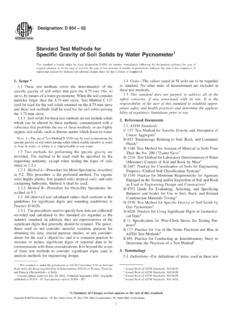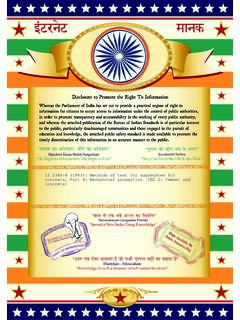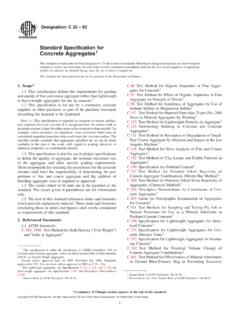Transcription of Standard Test Method for Sieve Analysis of Fine and Coarse ...
1 Designation: C 136 01 Standard Test Method forSieve Analysis of Fine and Coarse Aggregates1 This Standard is issued under the fixed designation C 136; the number immediately following the designation indicates the year oforiginal adoption or, in the case of revision, the year of last revision. A number in parentheses indicates the year of last reapproval. Asuperscript epsilon (e) indicates an editorial change since the last revision or Standard has been approved for use by agencies of the Department of Scope* This test Method covers the determination of the particlesize distribution of fine and Coarse aggregates by Some specifications for aggregates which reference thismethod contain grading requirements including both coarseand fine fractions.
2 Instructions are included for Sieve analysisof such The values stated in SI units are to be regarded as thestandard. The values in parentheses are provided for informa-tion purposes only. Specification E 11 designates the size ofsieve frames with inch units as Standard , but in this test methodthe frame size is designated in SI units exactly equivalent to theinch Standard does not purport to address all of thesafety concerns, if any, associated with its use. It is theresponsibility of the user of this Standard to establish appro-priate safety and health practices and determine the applica-bility of regulatory limitations prior to Referenced Standards:C 117 Test Method for Materials Finer Than 75- m ( ) Sieve in Mineral Aggregates by Washing2C 125 Terminology Relating to Concrete and Concrete Ag-gregates2C 670 Practice for Preparing Precision and Bias Statementsfor Test Methods for Construction Materials2C 702 Practice for Reducing Field Samples of aggregate toTesting Size2D 75 Practice for Sampling Aggregates3E 11 Specification for Wire-Cloth and Sieves for Standard :AASHTO No.
3 T 27 Sieve Analysis of Fine and CoarseAggregates53. For definitions of terms used in this stan-dard, refer to Terminology C Summary of Test A sample of dry aggregate of known mass is separatedthrough a series of sieves of progressively smaller openings fordetermination of particle size Significance and This test Method is used primarily to determine thegrading of materials proposed for use as aggregates or beingused as aggregates. The results are used to determine compli-ance of the particle size distribution with applicable specifica-tion requirements and to provide necessary data for control ofthe production of various aggregate products and mixturescontaining aggregates.
4 The data may also be useful in devel-oping relationships concerning porosity and Accurate determination of material finer than the 75- m(No. 200) Sieve cannot be achieved by use of this methodalone. Test Method C 117 for material finer than 75- m sieveby washing should be Balances or scales used in testing fine andcoarse aggregate shall have readability and accuracy as fol- For fine aggregate , readable to g and accurate g or % of the test load, whichever is greater, at anypoint within the range of For Coarse aggregate , or mixtures of fine and coarseaggregate, readable and accurate to g or % of the testload, whichever is greater, at any point within the range of The Sieve cloth shall be mounted on substantialframes constructed in a manner that will prevent loss ofmaterial during sieving.
5 The Sieve cloth and Standard sieve1 This test Method is under the jurisdiction of ASTM Committee C09 onConcrete and Concrete Aggregates and is the direct responsibility of on Normal Weight edition approved June 10, 2001. Published August 2001. Originallypublished as C 136 38 T. Last previous edition C 136 Book of ASTM Standards, Vol Book of ASTM Standards, Vol Book of ASTM Standards, Vol from American Association of State Highway and TransportationOfficials, 444 North Capitol St. , Suite 225, Washington, DC *A Summary of Changes section appears at the end of this ASTM International, 100 Barr Harbor Drive, PO Box C700, West Conshohocken, PA 19428-2959, United shall conform to the requirements of Specification E Sieve frames shall conform to the requirements ofSpecification E 11 as It is recommended that sieves mounted in frames larger thanstandard (8 in.)
6 Diameter be used for testing Coarse aggregate toreduce the possibility of overloading the sieves. See Sieve Shaker A mechanical sieving de-vice, if used, shall create motion of the sieves to cause theparticles to bounce, tumble, or otherwise turn so as to presentdifferent orientations to the sieving surface. The sieving actionshall be such that the criterion for adequacy of sievingdescribed in is met in a reasonable time Use of a mechanical Sieve shaker is recommended when thesize of the sample is 20 kg or greater, and may be used for smallersamples, including fine aggregate . Excessive time (more than approxi-mately 10 min) to achieve adequate sieving may result in degradation ofthe sample.
7 The same mechanical Sieve shaker may not be practical for allsizes of samples, since the large sieving area needed for practical sievingof a large nominal size Coarse aggregate very likely could result in loss ofa portion of the sample if used for a small sample of Coarse aggregate orfine An oven of appropriate size capable of main-taining a uniform temperature of 11065 C (23069 F).7. Sample the aggregate in accordance with Practice D size of the field sample shall be the quantity shown inPractice D 75 or four times the quantity required in and (except as modified in ), whichever is Thoroughly mix the sample and reduce it to an amountsuitable for testing using the applicable procedures described inPractice C 702.
8 The sample for test shall be approximately thequantity desired when dry and shall be the end result of thereduction. Reduction to an exact predetermined quantity shallnot be Where Sieve Analysis , including determination of materialfiner than the 75- m Sieve , is the only testing proposed, the size of thesample may be reduced in the field to avoid shipping excessive quantitiesof extra material to the aggregate The size of the test sample, afterdrying, shall be 300 g aggregate The size of the test sample ofcoarse aggregate shall conform with the following:Nominal Maximum Size,Square Openings, mm (in.)Test Sample Size,min, kg (lb) (3 8)1 (2) (1 2)2 (4) (3 4)5 (11) (1)10 (22) (11 2)15 (33)50 (2)20 (44)63 (21 2)35 (77)75 (3)60 (130)90 (31 2)100 (220)100 (4)150 (330)125 (5)300 (660) and Fine aggregate Mixtures The size of thetest sample of Coarse and fine aggregate mixtures shall be thesame as for Coarse aggregate in of Large Size Coarse aggregate The size ofsample required for aggregate with 50-mm nominal maximumsize or larger is such as to preclude convenient samplereduction and testing as a unit except with large mechanicalsplitters and Sieve shakers.
9 As an option when such equipmentis not available, instead of combining and mixing sampleincrements and then reducing the field sample to testing size,conduct the Sieve Analysis on a number of approximately equalsample increments such that the total mass tested conforms tothe requirement of In the event that the amount of material finer than the75- m (No. 200) Sieve is to be determined by Test MethodC 117, proceed as For aggregates with a nominal maximum size of (1/2 in.) or less, use the same test sample for testing byTest Method C 117 and this Method . First test the sample inaccordance with Test Method C 117 through the final dryingoperation, then dry Sieve the sample as stipulated in ofthis For aggregates with a nominal maximum size greaterthan mm (1 2in.)
10 , a single test sample may be used asdescribed in , or separate test samples may be used forTest Method C 117 and this Where the specifications require determination of thetotal amount of material finer than the 75- m Sieve by washingand dry sieving, use the procedure described in Dry the sample to constant mass at a temperature of 11065 C (23069 F).NOTE4 For control purposes, particularly where rapid results aredesired, it is generally not necessary to dry Coarse aggregate for the sieveanalysis test. The results are little affected by the moisture content unless:(1) the nominal maximum size is smaller than about mm (1 2in.); (2)the Coarse aggregate contains appreciable material finer than mm(No.)








